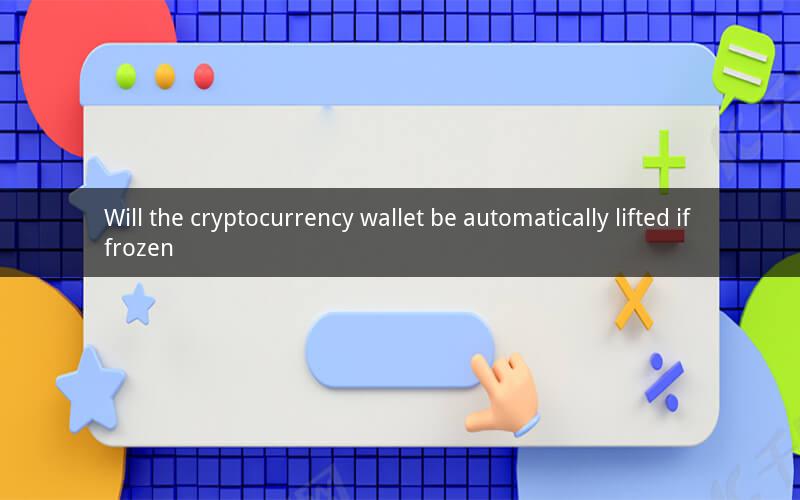
Understanding Cryptocurrency Wallet Freezes and Automatic Lifts
Table of Contents
1. Introduction to Cryptocurrency Wallets
2. What is a Wallet Freeze?
3. Reasons for Cryptocurrency Wallet Freezes
4. The Process of Freezing a Cryptocurrency Wallet
5. Automatic Lift of a Frozen Cryptocurrency Wallet
6. How to Prevent Wallet Freezes
7. Legal and Regulatory Considerations
8. Conclusion
1. Introduction to Cryptocurrency Wallets
Cryptocurrency wallets are digital storage solutions designed to hold, send, and receive cryptocurrencies. They come in various forms, including software wallets, hardware wallets, and paper wallets, each offering different levels of security and accessibility.
2. What is a Wallet Freeze?
A wallet freeze refers to the temporary restriction of access to a cryptocurrency wallet, preventing transactions or withdrawals. This measure is often taken by exchanges, wallet providers, or regulatory bodies to address potential security concerns or comply with legal requirements.
3. Reasons for Cryptocurrency Wallet Freezes
Several factors can lead to a cryptocurrency wallet being frozen, including:
- Security breaches or suspicious activity
- Compliance with anti-money laundering (AML) regulations
- Legal investigations or orders
- Identity verification issues
- Compliance with know your customer (KYC) policies
4. The Process of Freezing a Cryptocurrency Wallet
When a wallet freeze is initiated, the following steps typically occur:
1. Notification: The wallet owner is informed of the freeze and the reasons behind it.
2. Investigation: The wallet provider or relevant authority investigates the cause of the freeze.
3. Verification: Additional information or documentation may be requested to resolve the issue.
4. Resolution: The freeze is lifted or continues based on the investigation's outcome.
5. Automatic Lift of a Frozen Cryptocurrency Wallet
The automatic lift of a frozen cryptocurrency wallet is a process that occurs when the wallet provider determines that the issue has been resolved. Factors that may contribute to an automatic lift include:
- Resolution of security concerns
- Compliance with legal and regulatory requirements
- Verification of the wallet owner's identity
- Successful completion of the investigation
6. How to Prevent Wallet Freezes
To minimize the risk of wallet freezes, consider the following preventive measures:
- Implement strong security practices, such as using complex passwords and two-factor authentication.
- Regularly update wallet software to ensure you have the latest security features.
- Stay informed about AML and KYC requirements and comply with them promptly.
- Exercise caution when dealing with unfamiliar or suspicious entities.
7. Legal and Regulatory Considerations
Legal and regulatory considerations play a significant role in the freezing and lifting of cryptocurrency wallets. Some key points to consider include:
- Different jurisdictions have varying regulations regarding cryptocurrency and wallet operations.
- Compliance with AML and KYC policies is crucial to avoid wallet freezes.
- Transparency and cooperation with regulatory bodies can help resolve issues more quickly.
8. Conclusion
Understanding the reasons behind cryptocurrency wallet freezes and the process of lifting them is essential for users and wallet providers. By taking preventive measures and being aware of legal and regulatory requirements, the risk of wallet freezes can be minimized.
Questions and Answers
1. What is the primary purpose of freezing a cryptocurrency wallet?
- The primary purpose of freezing a cryptocurrency wallet is to address security concerns, comply with legal requirements, or investigate suspicious activity.
2. Can a wallet owner unfreeze their own wallet?
- In most cases, wallet owners cannot unfreeze their own wallets. The wallet provider or relevant authority must resolve the issue and initiate the unfreezing process.
3. How long can a cryptocurrency wallet remain frozen?
- The duration of a wallet freeze can vary depending on the circumstances. It may range from a few hours to several weeks or even months.
4. Are there any penalties for using a frozen cryptocurrency wallet?
- Using a frozen cryptocurrency wallet without permission can lead to penalties, including legal consequences and financial loss.
5. Can a frozen wallet be accessed by a third party?
- Access to a frozen wallet is limited and typically restricted to the wallet provider or relevant authority handling the investigation.
6. What should a wallet owner do if they receive a notification of a wallet freeze?
- A wallet owner should carefully review the notification and provide any requested information or documentation to help resolve the issue.
7. How can a wallet owner prevent their wallet from being frozen?
- A wallet owner can prevent a wallet freeze by adhering to strong security practices, staying informed about legal and regulatory requirements, and being cautious when dealing with unfamiliar entities.
8. Are there any specific regulations that can lead to a cryptocurrency wallet freeze?
- Several regulations, including AML and KYC policies, can lead to a cryptocurrency wallet freeze if not adhered to.
9. Can a frozen wallet be used to send or receive cryptocurrencies?
- A frozen wallet cannot be used to send or receive cryptocurrencies until the freeze is lifted.
10. How can a wallet owner verify the legitimacy of a wallet freeze notification?
- A wallet owner can verify the legitimacy of a wallet freeze notification by contacting the wallet provider or relevant authority directly and cross-referencing the information provided.